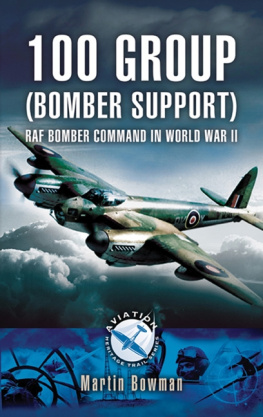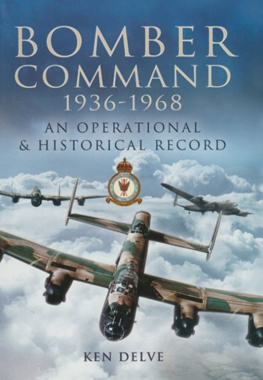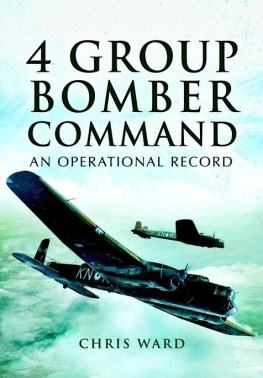
First published in Great Britain in 2009 by
Pen & Sword Aviation
an imprint of
Pen & Sword Books Ltd
47 Church Street
Barnsley
South Yorkshire
S70 2AS
Copyright Chris Ward 2009
ISBN 978 1 84884 155 0
Print ISBN: 978-1-84884-155-0
ePub ISBN: 9781844687329
The right of Chris Ward to be identified as Author of this Work has been
asserted by him in accordance with the Copyright,
Designs and Patents Act 1988.
A CIP catalogue record for this book is
available from the British Library
All rights reserved. No part of this book may be reproduced or transmitted in
any form or by any means, electronic or mechanical including photocopying,
recording or by any information storage and retrieval system, without permission
from the Publisher in writing.
Typeset in Times by
Phoenix Typesetting, Auldgirth, Dumfriesshire
Printed and bound in England by
CPI UK
Pen & Sword Books Ltd incorporates the Imprints of Pen & Sword Aviation,
Pen & Sword Maritime, Pen & Sword Military, Wharncliffe Local History,
Pen & Sword Select, Pen & Sword Military Classics and Leo Cooper.
For a complete list of Pen & Sword titles please contact
PEN & SWORD BOOKS LIMITED
47 Church Street, Barnsley, South Yorkshire, S70 2AS, England
E-mail:
Website: www.pen-and-sword.co.uk
Acknowledgements
Most of the figures used in the statistics section of this work, have been drawn from The Bomber Command War Diaries by Martin Middlebrook and Chris Everitt, and I am indebted to Martin Middlebrook for allowing me to use them.
A special mention is due to Chris Salter, now retired, and a founder of Midland Counties Publications, without whose generous assistance and encouragement at the outset, I would not have been able to compile a complete list of all operational aircraft on charge with Bomber Command squadrons during the war period, a list, incidentally, that comprises some 28,000 entries.
I am greatly indebted to Danny Bouchard in Canada for sourcing and processing the photographs, and for obtaining the permission of Library and Archives Canada to reproduce them in this publication. Danny is a serving police officer in Quebec, the holder of the Medal of Bravery, and is also a professional genealogist.
General Notes
This profile is a reference work on the activities of the Group and the squadrons serving with it in an operational capacity at some time during the Second World War. Bomber Command operated exclusively from stations in the UK, and used overseas bases purely for shuttle operations, or as advanced staging posts for specific purposes. For this reason, periods spent on detachment, or permanent postings to overseas Commands do not fall within the scope of this work.
This work is not intended to serve as a comprehensive history of the Group or squadrons, but to provide as much information as possible in the space available in a non-anecdotal form. The brief history narrative is basically an account of Bomber Commands war, with the Groups involvement interwoven into it. The publications listed in Section 5 are not only recommended reading, but represent some of the best available sources of information for serious students of the subject. The operational record is based almost entirely on the figures provided in The Bomber Command War Diaries by Martin Middlebrook and Chris Everitt, and I am indebted to Martin Middlebrook for allowing me to use them.
An aircraft is included in aircraft history section if; a) it spent time on squadron charge, no matter how briefly, and irrespectively of whether or not it operated and b) the type was used operationally by the squadron. Where a squadron has a Conversion Flight involving a type with which it is intending to re-equip, but then does not, as in the case of 101 and 460 Squadrons, these have been included, on the basis that they sometimes found themselves on operations. Information is restricted in most cases to where from and where to, unless it completed its service with the squadron, in which case, some detail of its demise appears. Aircraft that failed to return have the date and target recorded. Where no information follows the serial number of a type still in use when the squadron departed Bomber Command, or at wars end, it can be assumed that the aircraft was still on squadron strength. However, where there is a blank space following the serial number of a type that has been withdrawn from service with Bomber Command, it signifies that I dont know its ultimate fate. An absence of information does not imply that the aircraft flew no operations during its time with the squadron.
Finally, information has been drawn from a variety of sources, ranging from Records Branch to individuals with squadron connections, and I am grateful for their contributions. There will inevitably be errors and omissions when dealing with a subject as vast as Bomber Command, and I am happy to be corrected and/or updated by readers.
CHAPTER ONE
A Narrative History
The Seeds are Sown
On the 31st of October 1939, negotiations began between representatives of the British and Canadian governments on the subject of the British Commonwealth Air Training Plan (BCATP). Both sides approached the talks with entirely different perceptions and goals, and this would lead to protracted discussions and acrimonious relations over the following three years. The Canadianisation of Royal Canadian Air Force personnel serving with the Royal Air Force was enshrined in Article XV of the BCATP agreement, which was signed on the 7th of January 1941, and originally called for the formation of twenty-five RCAF squadrons overseas. These were to be financed by Canadas contribution to the Plan, still known to this day in the UK as the Empire Air Training Scheme, which was agreed at $350 million. From the outset the talks were dogged by the questions of control of the RCAF contingent and finance, and the Canadian negotiators found themselves being constantly out-manoeuvred by their British counterparts. Canada envisaged an independent air force operating alongside the RAF, much as the American 8th Air Force would from 1942. Britain, however, saw Canada as a source of manpower, and intended to integrate Canadian personnel into existing RAF Squadrons, or at least, to place the RCAF squadrons within RAF Groups. Canada expressed itself unwilling to finance RCAF personnel over whom it had no control, and after much wrangling, a compromise was eventually reached, which would allow all RCAF squadrons to operate from stations within close proximity to one another, and under the same RAF Group. All such units were to be numbered in the 400450 series. Once sufficient squadrons had been formed, a RCAF Group would come into existence. By the time that negotiations had reached this stage, it was already 1942, and only four RCAF squadrons had thus far been formed, all in 1941. In the event, outside influences caused the programme to be cut back, allowing for just seven new squadrons in 1942, making a total of eleven. However, the number was considered acceptable to constitute an effective Group, and this compromise became a cherished dream in itself, achieving realisation on the 1st of January 1943. Ultimately, this was the best that Canada could wrest from the deal, having been backed into a corner by its own negotiators, and thus the RAF acquired the manpower and the control, while Canada footed the bill.
On the day of its formation 6 Group comprised eight squadrons operating either Halifaxes or Wellingtons. 408 Squadron was stationed at Leeming under its long-standing commanding officer, W/C Tiny Ferris, and had only recently converted from Hampdens to the Rolls-Royce Merlin-powered Halifax Mks II and V. 419 and 420 Squadrons were at Middleton St George under W/Cs Fleming and Bradshaw respectively, the former having also recently traded in its Wellingtons for Halifaxes, while the latter owned a mixture of Wellington IIIs and Xs. 424 Squadron and its Wellington Mk IIIs and Xs resided at Topcliffe under W/C Carscallen, while the Wellington-equipped 425 and 426 Squadrons occupied Dishforth under the leadership respectively of W/Cs St Pierre and Blanchard. The two remaining Wellington squadrons were 427 at Croft with W/C Burnside at the helm, and 428 under W/C Earle at Dalton.
Next page


















